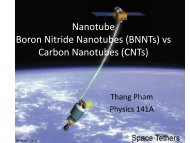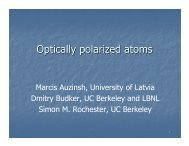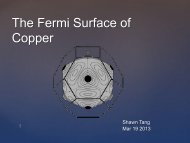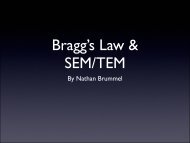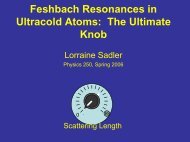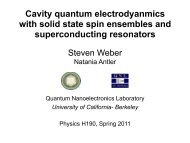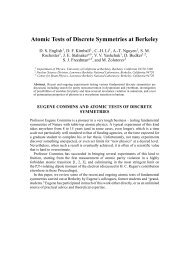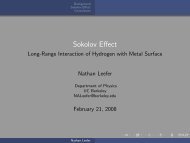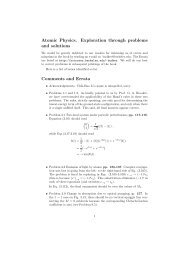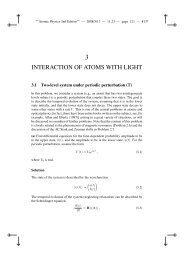Resonant nonlinear magneto-optical effects in atomsâ - The Budker ...
Resonant nonlinear magneto-optical effects in atomsâ - The Budker ...
Resonant nonlinear magneto-optical effects in atomsâ - The Budker ...
Create successful ePaper yourself
Turn your PDF publications into a flip-book with our unique Google optimized e-Paper software.
5<br />
sublevels <strong>in</strong> each <strong>in</strong>dividual atom. In forward scatter<strong>in</strong>g,<br />
the amplitudes of <strong>in</strong>dividual scatterers add <strong>in</strong> the scattered<br />
light (Corney et al., 1966; Durrant, 1972). Thus<br />
forward scatter<strong>in</strong>g is coherent, and <strong>in</strong>terference can be<br />
observed between sublevels belong<strong>in</strong>g to different atoms.<br />
<strong>The</strong> forward-scattered light has the same frequency as the<br />
<strong>in</strong>cident light. However, the phase of the scattered light<br />
depends on the relative detun<strong>in</strong>g between the <strong>in</strong>cident<br />
light and the atom’s effective resonance frequency. This<br />
leads to <strong>in</strong>homogeneous broaden<strong>in</strong>g of the FS resonance<br />
features; at low <strong>optical</strong> density, their width (<strong>in</strong> the magnetic<br />
field doma<strong>in</strong>) is determ<strong>in</strong>ed by the Doppler width<br />
of the spectral l<strong>in</strong>e. 5 For this reason, the correspond<strong>in</strong>g<br />
FS signals associated with the l<strong>in</strong>ear <strong>magneto</strong>-<strong>optical</strong> <strong>effects</strong><br />
can be regarded as Doppler-broadened, multi-atom<br />
Hanle resonances. Here the Hanle effect is regarded either<br />
as a manifestation of quantum mechanical <strong>in</strong>terference<br />
or atomic coherence, depend<strong>in</strong>g on whether it appears<br />
<strong>in</strong> emissive or dispersive properties of the medium<br />
(see Sec. II.D.1). If the <strong>optical</strong> density of the sample<br />
<strong>in</strong>creases to the extent that multiple scatter<strong>in</strong>g becomes<br />
important, substantial narrow<strong>in</strong>g of the observed signals<br />
results, <strong>in</strong>terpreted by Corney et al. (1966) as coherence<br />
narrow<strong>in</strong>g. Forward-scatter<strong>in</strong>g signal narrow<strong>in</strong>g was observed<br />
<strong>in</strong> Hg by Corney et al. (1966) and <strong>in</strong> Na by Krolas<br />
and W<strong>in</strong>iarczyk (1972). Further explor<strong>in</strong>g the relation<br />
between manifestations of s<strong>in</strong>gle- and multi-atom<br />
coherence, Corney, Kibble, and Series analyzed the phenomenon<br />
of double resonance <strong>in</strong> the context of FS. This<br />
is a two-step process <strong>in</strong> which first <strong>optical</strong> excitation by<br />
appropriately polarized resonant light populates atomic<br />
states. Subsequently, transitions are <strong>in</strong>duced among the<br />
excited states by a resonant radio-frequency (rf) field.<br />
Corney, Kibble, and Series also studied double resonance<br />
<strong>in</strong> the limit<strong>in</strong>g case <strong>in</strong> which the upper states have the<br />
same energy, so that the second resonance occurs at zero<br />
frequency. Such a zero-frequency resonant field is simply<br />
a constant, transverse magnetic field. Thus the doubleresonance<br />
approach is applied to the Voigt effect <strong>in</strong> an<br />
unorthodox manner.<br />
<strong>The</strong> fact that <strong>in</strong> forward scatter<strong>in</strong>g light scattered by<br />
different atoms is coherent makes it possible to study<br />
the phenomenon of l<strong>in</strong>e cross<strong>in</strong>g. Whereas <strong>in</strong> level cross<strong>in</strong>g<br />
(Colegrove et al., 1959; Franken, 1961), signals <strong>in</strong><br />
lateral light scatter<strong>in</strong>g are observed when different sublevels<br />
of s<strong>in</strong>gle atoms cross (for example, <strong>in</strong> an external<br />
magnetic field), <strong>in</strong> a l<strong>in</strong>e-cross<strong>in</strong>g experiment <strong>in</strong>terference<br />
occurs due to cross<strong>in</strong>g of sublevels of different atoms.<br />
This effect was first demonstrated by Hackett and Series<br />
(1970). <strong>The</strong>se authors observed <strong>in</strong>terference <strong>in</strong> the<br />
FS signals due to cross<strong>in</strong>g of Zeeman sublevels of different<br />
Hg isotopes conta<strong>in</strong>ed <strong>in</strong> one cell. Church and<br />
Hadeishi (1973) showed that l<strong>in</strong>e cross<strong>in</strong>g occurs even<br />
5 Obviously, homogeneous broaden<strong>in</strong>g (e.g., pressure broaden<strong>in</strong>g)<br />
also affects these widths.<br />
when atoms of different k<strong>in</strong>ds are conta<strong>in</strong>ed <strong>in</strong> separate<br />
cells. Hackett and Series (1970), Church and Hadeishi<br />
(1973), Stanzel (1974a), and Siegmund and Scharmann<br />
(1976) <strong>in</strong>vestigated the possibility of apply<strong>in</strong>g the l<strong>in</strong>ecross<strong>in</strong>g<br />
effect to precise measurements of isotope shifts.<br />
This idea is based on the fact that l<strong>in</strong>e cross<strong>in</strong>gs occur<br />
when the applied magnetic field is such that the Zeeman<br />
shifts compensate for the <strong>in</strong>itial field-free isotope shifts.<br />
It was hoped that strong coherence narrow<strong>in</strong>g of the l<strong>in</strong>ecross<strong>in</strong>g<br />
resonance would significantly <strong>in</strong>crease precision<br />
of such measurements. However, these authors found<br />
that various complications (aris<strong>in</strong>g, for example, from<br />
pressure broaden<strong>in</strong>g of the signals), render this method<br />
impractical for isotope shift measurements.<br />
Forward-scatter<strong>in</strong>g signals for weak-<strong>in</strong>tensity light can<br />
be written as<br />
I F S = 1 4<br />
∫<br />
+<br />
∫<br />
ξ(ω)<br />
[e − A + ωl<br />
c<br />
ξ(ω) s<strong>in</strong> 2 {<br />
(n + − n − ) ωl<br />
2c<br />
]<br />
− e − A − 2dω<br />
ωl<br />
c<br />
}<br />
e − (A + +A − )ωl<br />
c dω, (4)<br />
where ξ(ω) is the spectral density of the <strong>in</strong>cident light,<br />
A ± and n ± denote amplitude absorption coefficients and<br />
refractive <strong>in</strong>dices for the σ ± components of the <strong>in</strong>cident<br />
light beam, respectively, and l is the sample length. We<br />
assume ideal polarizers here.<br />
In general, there are two comparable contributions to<br />
the FS signal, represented by the two terms <strong>in</strong> Eq. (4).<br />
<strong>The</strong> first term is due to differential absorption of the σ +<br />
and σ − components of the <strong>in</strong>cident light (circular dichroism),<br />
and the second term is due to differential dispersion<br />
(circular birefr<strong>in</strong>gence). <strong>The</strong> two contributions have<br />
different frequency dependence. This can be illustrated<br />
with the simple case of the F = 0 → F ′ = 1 transition,<br />
for which the σ ± resonance frequencies are split by a longitud<strong>in</strong>al<br />
magnetic field (Fig. II.B). While the function<br />
<strong>in</strong> the first <strong>in</strong>tegral goes through zero at ω = ω 0 (s<strong>in</strong>ce<br />
the function <strong>in</strong> the square brackets is anti-symmetric with<br />
respect to detun<strong>in</strong>g), the second (birefr<strong>in</strong>gence) term is<br />
maximal at zero detun<strong>in</strong>g (for small magnetic fields). For<br />
a narrow-band light source, it is possible to elim<strong>in</strong>ate the<br />
dichroic contribution by tun<strong>in</strong>g to the center of the resonance.<br />
One is then left with only the second <strong>in</strong>tegral,<br />
represent<strong>in</strong>g Malus’s law, where ϕ = (n + − n − )ωl/(2c) is<br />
the Faraday rotation angle [Eq. (1)].<br />
When the density-length product for the medium is<br />
sufficiently high, the range of variation of ϕ can easily<br />
exceed π, and <strong>in</strong>tensity transmitted through the apparatus<br />
shown <strong>in</strong> Fig. I oscillates as a function of the magnetic<br />
field (Fig. II.B). <strong>The</strong>se oscillations are clearly seen despite<br />
the proximity of the absorption l<strong>in</strong>e because the<br />
refractive <strong>in</strong>dices drop with detun<strong>in</strong>g slower than the absorption<br />
coefficients. When ξ(ω) represents a narrow<br />
spectral profile, the modulation contrast can be high,<br />
particularly when the magnetic field is strong enough<br />
to split the A ± profiles completely. Such case is shown<br />
schematically <strong>in</strong> Fig. II.B(c).





